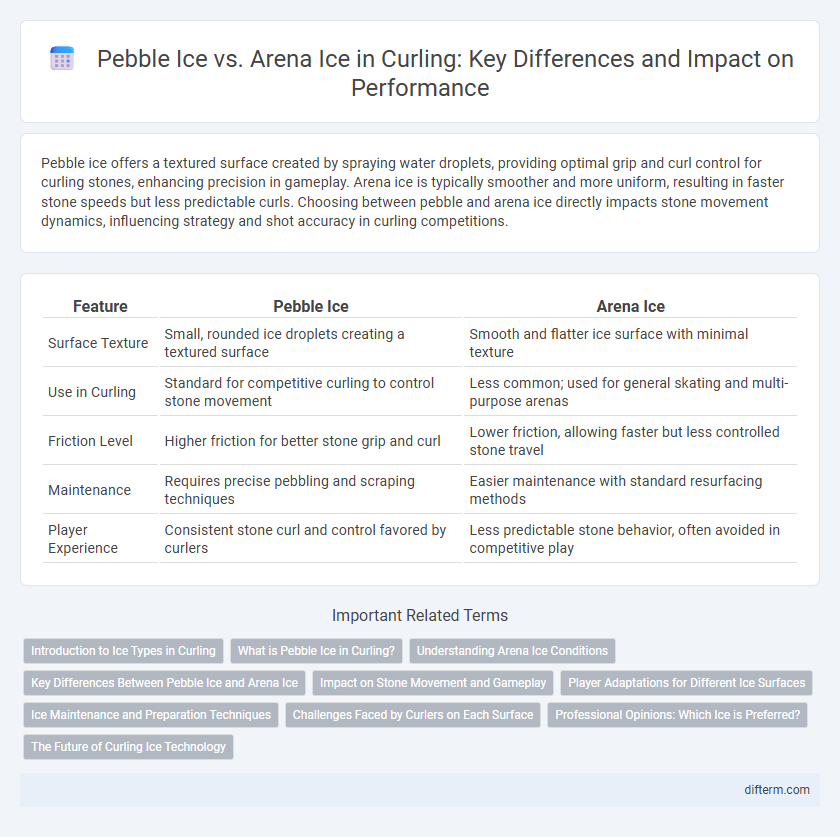Pebble ice offers a textured surface created by spraying water droplets, providing optimal grip and curl control for curling stones, enhancing precision in gameplay. Arena ice is typically smoother and more uniform, resulting in faster stone speeds but less predictable curls. Choosing between pebble and arena ice directly impacts stone movement dynamics, influencing strategy and shot accuracy in curling competitions.
Table of Comparison
| Feature | Pebble Ice | Arena Ice |
|---|---|---|
| Surface Texture | Small, rounded ice droplets creating a textured surface | Smooth and flatter ice surface with minimal texture |
| Use in Curling | Standard for competitive curling to control stone movement | Less common; used for general skating and multi-purpose arenas |
| Friction Level | Higher friction for better stone grip and curl | Lower friction, allowing faster but less controlled stone travel |
| Maintenance | Requires precise pebbling and scraping techniques | Easier maintenance with standard resurfacing methods |
| Player Experience | Consistent stone curl and control favored by curlers | Less predictable stone behavior, often avoided in competitive play |
Introduction to Ice Types in Curling
Pebble ice in curling is created by spraying water droplets onto the rink, forming small, textured bumps that enhance stone grip and control during play. Arena ice, typically found in multi-use venues, has a smoother surface but often lacks the consistent pebble texture essential for optimal stone movement. Understanding the difference between pebble ice and arena ice is crucial for curlers seeking precision and strategy in competitive matches.
What is Pebble Ice in Curling?
Pebble ice in curling refers to the textured surface created by spraying small droplets of water onto the curling sheet, which then freeze into tiny bumps. This pebbling reduces friction, allowing curling stones to glide smoothly and curl more predictably. High-quality pebble ice ensures consistent stone speed and accurate shot placement during competitive games.
Understanding Arena Ice Conditions
Arena ice in curling features a smoother surface with fewer imperfections compared to pebble ice, leading to more consistent stone behavior. The temperature and humidity inside an arena are carefully controlled to maintain optimal ice hardness, directly affecting the curl and speed of the stones. Understanding these conditions allows players to adjust their delivery and strategy to maximize precision during gameplay.
Key Differences Between Pebble Ice and Arena Ice
Pebble ice in curling features a textured surface created by spraying water droplets that freeze into small, round bumps, enhancing stone grip and enabling precise curl control. Arena ice, typically used in larger multi-sport venues, has a smoother surface with less pronounced pebbling, resulting in faster stone speeds and reduced curl due to its uniform ice texture. Understanding these ice conditions is crucial for strategizing shot selection and adapting gameplay during competitive curling matches.
Impact on Stone Movement and Gameplay
Pebble ice creates a textured surface that reduces friction, allowing curling stones to glide farther and curl more predictably, enhancing precision in shot-making. Arena ice, typically smoother with less pronounced pebble, results in less consistent stone movement and requires players to adjust their delivery force and angle. The choice between pebble and arena ice directly impacts gameplay strategy, including shot selection and sweeping techniques, influencing overall match outcomes.
Player Adaptations for Different Ice Surfaces
Players adjust their delivery speed and rotation based on the distinct surface texture of pebble ice versus arena ice in curling. Pebble ice, characterized by a coarser texture, demands lighter weight and softer release to maximize curl, whereas smoother arena ice allows for faster delivery and sharper turns. Mastery of these adaptations enhances shot precision and overall game strategy across varying ice conditions.
Ice Maintenance and Preparation Techniques
Pebble ice in curling is created by spraying water droplets onto the ice surface, forming small, rounded bumps that enhance stone grip and control. Arena ice requires precise temperature and humidity regulation to maintain a flat, consistent surface, with ice technicians using specialized machines for shaving and pebbling. Regular scraping and pebbling cycles optimize playing conditions by balancing the ice texture and minimizing frost buildup.
Challenges Faced by Curlers on Each Surface
Pebble ice presents uneven surfaces that challenge curlers with unpredictable stone curls and reduced control, requiring precise weight and line judgment. Arena ice, typically smoother but warmer, induces faster stone speeds and less consistent pebble retention, demanding adjustments in sweeping techniques and shot timing. Both surfaces test a curler's adaptability, with pebble ice emphasizing finesse and arena ice prioritizing rapid reaction and strategy shifts.
Professional Opinions: Which Ice is Preferred?
Professional curlers often favor arena ice for its consistent speed and predictability during championship events, attributing their performance to its smoother surface and uniform pebble distribution. Pebble ice, while traditional, tends to create more variable stone behavior due to irregular pebble size and spacing, which some players find less reliable under competitive pressure. Many top athletes prioritize arena ice because it enhances precise shot-making and strategic play, essential for high-level curling tournaments.
The Future of Curling Ice Technology
Advancements in curling ice technology are reshaping the future of pebble ice and arena ice surfaces, enhancing stone control and game precision. Innovations in temperature regulation, pebble distribution, and ice maintenance equipment optimize playing conditions for competitive curling arenas. These technological improvements promise consistent ice quality, reducing variability and elevating athlete performance in elite tournaments.
pebble ice vs arena ice (curling) Infographic

 difterm.com
difterm.com